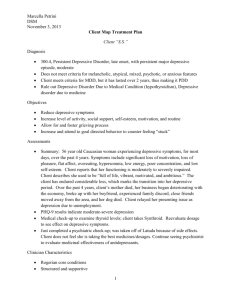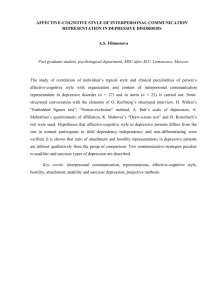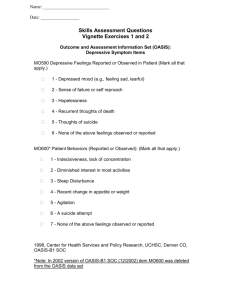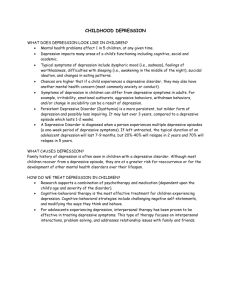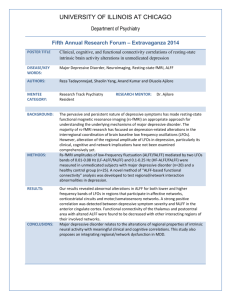HOW PARENT'S SOCIOECONOMIC STATUS, EXPOSURE TO
advertisement
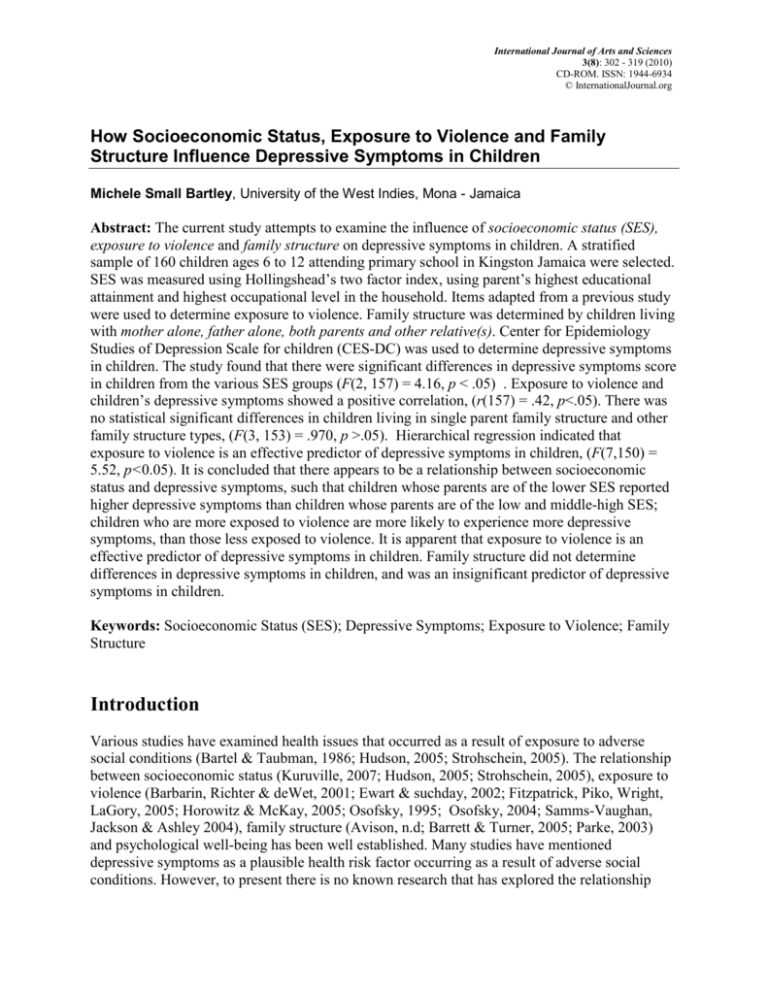
International Journal of Arts and Sciences 3(8): 302 - 319 (2010) CD-ROM. ISSN: 1944-6934 © InternationalJournal.org How Socioeconomic Status, Exposure to Violence and Family Structure Influence Depressive Symptoms in Children Michele Small Bartley, University of the West Indies, Mona - Jamaica Abstract: The current study attempts to examine the influence of socioeconomic status (SES), exposure to violence and family structure on depressive symptoms in children. A stratified sample of 160 children ages 6 to 12 attending primary school in Kingston Jamaica were selected. SES was measured using Hollingshead’s two factor index, using parent’s highest educational attainment and highest occupational level in the household. Items adapted from a previous study were used to determine exposure to violence. Family structure was determined by children living with mother alone, father alone, both parents and other relative(s). Center for Epidemiology Studies of Depression Scale for children (CES-DC) was used to determine depressive symptoms in children. The study found that there were significant differences in depressive symptoms score in children from the various SES groups (F(2, 157) = 4.16, p < .05) . Exposure to violence and children’s depressive symptoms showed a positive correlation, (r(157) = .42, p<.05). There was no statistical significant differences in children living in single parent family structure and other family structure types, (F(3, 153) = .970, p >.05). Hierarchical regression indicated that exposure to violence is an effective predictor of depressive symptoms in children, (F(7,150) = 5.52, p<0.05). It is concluded that there appears to be a relationship between socioeconomic status and depressive symptoms, such that children whose parents are of the lower SES reported higher depressive symptoms than children whose parents are of the low and middle-high SES; children who are more exposed to violence are more likely to experience more depressive symptoms, than those less exposed to violence. It is apparent that exposure to violence is an effective predictor of depressive symptoms in children. Family structure did not determine differences in depressive symptoms in children, and was an insignificant predictor of depressive symptoms in children. Keywords: Socioeconomic Status (SES); Depressive Symptoms; Exposure to Violence; Family Structure Introduction Various studies have examined health issues that occurred as a result of exposure to adverse social conditions (Bartel & Taubman, 1986; Hudson, 2005; Strohschein, 2005). The relationship between socioeconomic status (Kuruville, 2007; Hudson, 2005; Strohschein, 2005), exposure to violence (Barbarin, Richter & deWet, 2001; Ewart & suchday, 2002; Fitzpatrick, Piko, Wright, LaGory, 2005; Horowitz & McKay, 2005; Osofsky, 1995; Osofsky, 2004; Samms-Vaughan, Jackson & Ashley 2004), family structure (Avison, n.d; Barrett & Turner, 2005; Parke, 2003) and psychological well-being has been well established. Many studies have mentioned depressive symptoms as a plausible health risk factor occurring as a result of adverse social conditions. However, to present there is no known research that has explored the relationship International Journal of Arts and Sciences 3(8): 302 - 319 (2010) CD-ROM. ISSN: 1944-6934 © InternationalJournal.org between socioeconomic status, exposure to violence, family structure and depressive symptoms in Jamaican children 6 to 12 years of age. The present study attempts to examine the influence of socioeconomic status, exposure to violence and family structure on depressive symptoms in Jamaican children 6 to 12 years of age. Background Depression is a psychopathological disorder (Bahls, 2001; Hirschfield et al., as cited in Cicchetti & Toth, 1998), influenced by three major factors, genetic, developmental, and social (Hazel, 2002; Sokolova, 2003). Depression stretches across all social boundaries, and was noted to have affected 121 million people worldwide in 2000 (World Health Organisation, 2007). According to the World Health Organization (2007) depression is projected as the second leading contributor to global burden of diseases for all ages and both sexes in 2020, as calculated by the Disability Adjusted Life Years. Children are not immune to the ills of depression, but in former years, developmental issues resembling that of depression inhibited the recognition of the disorder (Bahls, 2002; Rie as cited in Cicchetti et al., 1998; Hazel, 2002.). It was not until 1975 that the National Institute of Mental Health (NIMH) officially recognized the likelihood of depression in children (Bahls, 2002). The acceptance of childhood depression by the NIMH paved the way for research in childhood depression. Since then, studies have found that the prevalence of depression among children 6 to 12 years of age range between 0.4 to 3.0% (Balhs, 2002). Depression is characterized by various symptoms (American Psychiatric Association, 2000). Developmental challenges such as inability to adequately verbalize thoughts and feelings (Piaget, as cited in Santrock, 2000), may cause children to exhibit depressive symptoms in slightly different ways from symptoms exhibited in adolescents or adults (Versiani et al., as cited in Bahls, 2002). Symptoms of anger, impaired attention, poor concentration (Bhatia & Bhatia, 2006), irritability, hyperactivity, frequent mood change, restlessness and fatigue (Bahls, 2002; Semrud-Clikeman et al., 1991) are likely symptoms to be observed in children 6 to 12 years of age. Socioeconomic status Exposure to adverse social conditions has been proven to affect the psychological health of children (Gillman, 2003; Hudson, 2005; McLeod & Shanahan, 1996). To date, most studies have emphasized that the limited resources and unequal distribution of wealth in a society act as a mediating force to increase the risk of psychological effects of people living within the lower socioeconomic groups (Evans, 2004; Hudson, 2005; McLeod & Shanahan, 1993, 1996). As a result, the inextricable link that exists between exposure to negative conditions and mental health substantiates the increase risk of depressive symptoms in children from the lower socioeconomic status (McLeod et al., 1996). International Journal of Arts and Sciences 3(8): 302 - 319 (2010) CD-ROM. ISSN: 1944-6934 © InternationalJournal.org The Jamaican socioeconomic system primarily emerging from slavery and colonialism has created an arena for segregation and social stratification of the Jamaican society (Bryan, 2000). This stratification chiefly predetermined the privileges and benefits afforded to each social group (Thompson, 1997). Consequently, those living within the lower socioeconomic groups have less access to social and economic benefits. A substantial body of evidence reveals that there is a clear demarcation between the various socioeconomic groups, such that, parents of children with high educational attainment and prestigious occupation are at a greater advantage of offering their children opportunities for higher education, access to wealth, use of stimulating resources (Brooks-Gunn et al., as cited in Bradley et al., 2002; Galobardes, et al., 2007; Strohschien, 2005), and homes in safer residential communities (Samms-Vaughan et al., 2004; Kuruvilla & Jacob, 2007). Typically, the privileges afforded to children of higher socioeconomic groups magnify their chances of experiencing more wholesome life styles than those of the lower socioeconomic groups (Brook-Gunn et al., 1997), undoubtedly reducing the risk of psychological effects in these children. Exposure to violence A vast number of studies have examined the relationship between exposure to violence and children’s psychological well-being (Barbarin et al., 2001; Fitzpatrick et al., 2005, Fantuzzo et al., 1999; Meeks Gardener & Powell, 2005; Osofsky 1995; Osofsky & Osofsky, 1999; Osofsky, 2004). Although a few studies have explored exposure to violence among Jamaican children (Samms-Vaughan, 2006; Soyibo & Lee, 2000), no known research has specifically investigated the direct relationship of exposure to violence and depressive symptoms in Jamaican children 6 to 12 years of age. High crime rates and concentrated violent activities reported in Kingston Jamaica (Harriot, 2003) are likely to affect children’s psychological well-being (Samms-Vaughan, et al., 2004), and by extension upset their developmental pathway (Osofsky, 1995). Exposure to violence can be traumatizing for children, resulting in reactive response that can be fairly negative (Osofsky, 1995). The effects of violence can result in lifelong issues that consequently disturb adequate social and psychological development (Osofsy, 2004; Samms-Vaughan, et al., 2004). Violent exposures can occur through various avenues - the community, home and school (Fitzpatrick, et al., 2005; Meeks Gardener, et al., 2005; Osofsky, 1995). Samms-Vaughan, et al., (2004) alleged that the community is the primary source through which Jamaican children witness most violent activities. A recent study investigating the types of violent exposures in a sample of Jamaican children indicated that a significant number of children experience verbal aggression, fights on their way to school, while two fifth experienced sexual assault and witnessed others being stabbed, and few encountered someone being “shot at” (SammsVaughan, as cited in Samms-Vaughan, 2006, p. 51). Violence occurring at home can have great effects on children (Fantuzzo et al, 1999; Osofsky, 1995). Both victimization and witnessing violence within the home can be devastating (Osofsky 1995), resulting in equally similar psychological responses in children (Richters et al., as cited in Barbarin et al., 2001). International Journal of Arts and Sciences 3(8): 302 - 319 (2010) CD-ROM. ISSN: 1944-6934 © InternationalJournal.org Another overwhelming experience of violence occurring in the lives of children may occur at school. Many Jamaican schools are overwhelmed with violence among peers, as well as teachers and students conflicts (Meeks Gardener, 2005). Exposure to violence in any form can potentially harmful to children, placing them at an increased risk of experiencing depressive symptoms during childhood (Osofsky, 1995). Family structure The family is the core, and most essential unit in all societies (O’Donnell. 1993). The family essentially forms the foundation for which both positive and negative experiences are encountered (Seaga, 2005). As children grow their perception, self-concept, values and beliefs are cultured by the practices and norms within the family in which they are nurtured (Berk, 2001; Santrock, 2000). Family structure has been proven to impact psychological functioning in children (Avison, n.d; Barrett & Turner, 2005). Studies have suggested that children from single parent households have a greater propensity of increased psychological effects (Barrett et al., 2005; McLanahan et al, as cited in Parke, 2003). Clearly, the limited social and economical resources available to single parent households in some instances might act as a precursor to children’s psychological response (Avison, n.d; Barrett et al., 2005). The Jamaican society has throughout time shown a pattern of matrifocal households (LeoRyhnie, 1993; Smith, 1998), that is, household headed by females. Supporting this idea, the most recent study of Jamaican Survey of Living Conditions (2007) indicated that more than half (54.7%) of the households being surveyed were households headed by females - defined as “no man, with children”. These female headed households were spread across all social boundaries, indicative of the normative practices through the society. Although this practice prevails in the Jamaican society, assessing its effect on children’s psychological health is paramount. Summary Because of the unique cultural norms and practices in the Jamaican society, the study proposes to examine the influence of specific social factors and practices on depressive symptoms in children. As such, the study will attempt to examine three (3) possible factors that may influence depressive symptoms in children 6 to 12 years of age. Firstly, the study will examine the relationship between socioeconomic status and childhood depressive symptoms. Secondly, the study will investigate the relationship between exposure to violence and childhood depressive symptoms. Fourthly, family structure and depressive symptoms will be explored, that is, to determine if the type of family structure will influence depressive symptoms in children. Overall, the study will also explore if socioeconomic status, exposure to violence and family structure are predictors of childhood depressive symptoms. The present study attempt to answer the following questions with regards to Jamaican children 6 to 12 years of age: 1. Does socioeconomic status influence depressive symptoms in children? International Journal of Arts and Sciences 3(8): 302 - 319 (2010) CD-ROM. ISSN: 1944-6934 © InternationalJournal.org 2. Is there a relationship between exposure to violence and depressive symptoms? 3. Does the family structure influence depressive symptoms? 4. Are socioeconomic status, exposure to violence and family structure predictors of childhood depressive symptoms? The study will attempt to expand the knowledge and understanding of children’s psychological well-being at three (3) specific levels, namely the community (general public), schools (teachers and principals) and homes (parents). The study will also provide information for the development of social interventions to ameliorate the social conditions within communities, schools, homes and by extension the wider Jamaican population. Hypotheses This study examines the influence of socioeconomic status (SES), exposure to violence, family structure on depressive symptoms in children 6 to 12 years of age. As such, the following as been hypothesized: Hypothesis one (1). Significant differences in depressive symptoms exist among groups of children from different SES. Hypothesis two (2). There is a positive relationship between exposure to violence and symptoms of depression in children. Hypothesis three (3). Depressive symptoms are comparatively the same in children living in single parent households and those living with both parents households. Hypothesis four (4). Exposure to violence, family structure and socioeconomic status are predictors of symptoms of depression. Method Participants A stratified sample of 160 children was selected from four (4) primary schools in Kingston Jamaica. The sample consisted of children 6 to 12 years of age with a mean age of 9.11, (SD = 1.87 years), 51.2% of the sample represented male, and 48.8% represented female. Procedure Consent forms were obtained from each participant’s parent. A short socioeconomic status questionnaire was completed by each participant’s parent, and returned to the school. A questionnaire with research instructions consisting of three sections, the depression scale, a series of questions related to exposure to violence, and a series of questions regarding demographics were administered to children. Younger children were interviewed by the main researcher and research assistants who were previously trained to execute the task. Measures Socioeconomic Status (SES). Hollingshead’s two factor index using parents’ highest educational attainment and highest occupational level in the household was used to measure socioeconomic International Journal of Arts and Sciences 3(8): 302 - 319 (2010) CD-ROM. ISSN: 1944-6934 © InternationalJournal.org status. Scores on the SES ranged from 0 to 66 with 0 to 29 scores reflected lower SES, 30 to 39 scores reflected low SES and 40-66 scores reflecting middle to high SES. Depression scale. The Center for Epidemiological Studies of Depression Scale for Children (CES-DC) consisted of 20 items. Scores on the CES-DC range from 0 to 60, with higher scores representing greater symptoms of depression. Children were asked to report how they felt during that last two weeks. The responses were recorded using a four point response scale, 0 represented “Not At All”, 1 represented “A Little”, 2 represented “Some” and 3 represented “A Lot”. The CES-DC was designed to measure depressive symptoms in children ages 6 to 17 years of age (Rey & Birmaher, 2009). The CES-DC showed good internal reliability (α = .88) in the present study. Additionally, good internal consistency reliability and construct validity can be noted in other studies (Dancho, 2004; Faulstich, Carey, Ruggiero, Enyart, & Gresham, 1986). Exposure to violence. Items were adapted from a previous study done in Jamaica on exposure to crime and violence (Samms-Vaughan, et al., 2004). The 34-item scale assessed exposure to violence at home, school and in the community where children reside. Responses were recorded using a two point response scale, 0 represented “no”, 1 represented “yes”. The scale showed a good internal reliability (α = .90). Demographic data. A series of questions related to information on children’s demographics were requested, this included age, gender, grade, and persons with whom they live. Statistical Analysis Prior to the formal analyses, a series of checks were done on the quality of the data. First, an examination was made of the extent of missing values for each question on the questionnaire. No question was found to be missing more than 5% of responses. As such, the mean score was entered for missing values on each variable, with the exception of nominal values such as gender. Descriptive statistics were used to obtain the frequency distributions and scatterplots of the independent and dependent variables in order to check the normality of the distributions, to identify outlying scores, and to check for the linearity and heteroscedasticity of scores. Data transformations were done where required. Results Socio-economic Status (SES) and Depressive Symptoms The significant differences in depressive symptoms that exist among children from different socioeconomic status were examined using a one-way Analysis of Variance (ANOVA), with support of a Bonferonni post-hoc tests to determine which groups differed. Consistent with hypothesis one (1), statistical significant differences between groups of SES were found, (F(2, 157) = 4.16, p < .05). Post-hoc comparison indicated that there was a statistical significant difference between in the depressive symptoms scores in children from lower SES and those from low SES at the 5% level of significance. Statistical difference was noted in depressive International Journal of Arts and Sciences 3(8): 302 - 319 (2010) CD-ROM. ISSN: 1944-6934 © InternationalJournal.org symptoms for low and middle-high SES at the 10% level of significance. No statistical difference was noted between lower and middle-high SES. Table 1 Mean Depressive Symptoms Scores by Groups of Socioeconomic Status (SES) Depressive Symptoms Scores SES Groups Mean SD Lower Low Middle-High 25.37 19.24 21.52 9.81 8.64 11.38 Note. F (2, 157) = 4.16, p < .05 Table 2 Differences in Mean Depressive Symptoms Scores Among Groups of Socioeconomic Status (A) SES Lower SES Low SES Middle-High SES (B) SES Low SES Middle-High SES Lower SES Middle-High SES Lower SES Low SES Mean Difference (A-B) 6.13* 3.85 -6.13* -2.28 -3.85 2.28 Note.*p<0.05 Exposure to Violence and Depressive Symptoms The relationship between exposure to violence and depressive symptoms was explored using simple correlation analysis. Consistent with hypothesis two (2), exposure to violence was significantly associated with depressive symptoms, (r(159) = .42, p < .01). Results indicated a positive correlation between exposure to violence and depressive symptoms, such that the greater the mean score for exposure to violence, the higher the mean scores for depressive symptoms. (See Figure 1). International Journal of Arts and Sciences 3(8): 302 - 319 (2010) CD-ROM. ISSN: 1944-6934 © InternationalJournal.org Figure 1 Family Structure and Depressive Symptoms The significant differences in depressive symptoms that exist among children from different family structure were examined using a one-way Analysis of Variance (ANOVA). Consistent with hypothesis three (3), children from single parent households showed comparatively the same depressive symptoms like that of other households. No statistically significant differences were found between the various family structures and depressive symptoms scores, (F(3, 153) = .970, p >.05). (See Table 3) Table 3 Mean Depressive Symptoms Scores by Family Structure Symptoms of Depression Scores Family Structure Mean SD Mother Alone Father Alone Both Parents Other Relative 21.56 23.31 23.03 26.44 8.75 12.49 12.28 5.66 Note. F(3, 153) = .970, p >.05 International Journal of Arts and Sciences 3(8): 302 - 319 (2010) CD-ROM. ISSN: 1944-6934 © InternationalJournal.org Predictors of Depressive Symptoms To investigate how well exposure to violence, family structure and socioeconomic status predict depressive symptoms in children, when controlling for age, a hierarchical linear regression was computed. At the first stage of the analysis the main effects of age was added to the model. At the second stage of analysis, exposure to violence and types of family structure – mother alone, father alone, both parents and other relative or friend were added to the model. The third stage of the analysis, the different groups of socioeconomic status was added to model. When age was entered alone, it did not statistically predict symptoms of depression, F(1,154) = 2.56, p>0.05, - adjusted R2 = 0.01. This indicated that only 1% of the variance in depressive symptoms was predicted by age. When the exposure to violence and family structure was added, the prediction was improved, R2 change = 0.18, F(5,150) = 8.34, p<0.05. No statistical significance was noted for each type of family structure. However, when socioeconomic status was added to the model R2 change = 0.01, F(7,150) = 1.08, p<0.05. Results of this regression analysis indicated that exposure to violence was the only effective predictor of depressive symptoms, F(7,150) = 5.52, p<0.05. (See Table 4) Table 4 Hierarchical Multiple Regression Analysis Summary for Exposure to Violence, Family Structure, Socioeconomic Status Controlling for Age, Predicting Depressive Symptoms in Children Predictor B Beta t 0.72 0.13 1.60 Step 1 Age Constant Step 2 Age Exposure to Violence Family Structure Mother alone Father alone Other Constant Step 3 Age Exposure to Violence Family Structure Mother alone 13.25 3.38 0.18 0.59 0.03 0.41 4.20 5.45* -2.02 0.64 2.48 15.41 -0.94 0.02 0.08 -1.81 0.22 0.97 3.67 0.15 0.56 0.03 0.39 0.34 5.05* -2.07 -0.94 -1.18 International Journal of Arts and Sciences 3(8): 302 - 319 (2010) CD-ROM. ISSN: 1944-6934 © InternationalJournal.org Father alone Other Socioeconomic Status Low Middle-High -0.97 2.14 -0.00 0.07 -0.03 0.83 -2.32 -2.39 -0.08 -0.11 -0.98 -1.38 Note. *p<0.05. Discussion The main focus of the present study was to determine if socioeconomic status, exposure to violence and family structure influence depressive symptoms in children 6 to 12 years of age. Socioeconomic status (SES) The present study found that socioeconomic status indexed by the highest parental education and occupation in the household was significantly related to depressive symptoms in children. The findings supported hypothesis one (1) that significant differences in depressive symptoms were noted between the various SES groups. Additionally, the study also found that socioeconomic status was not an effective predictor of depressive symptoms in children. The findings are consistent with a growing body of research which emphasizes that there is a relationship between socioeconomic status and depressive symptoms in children, such that children from the lower socioeconomic status are at a greater risk of experiencing psychological issues than those of other socioeconomic status (Hudson, 2005; Strohschein, 2005). The mediating influences used to explain the association between socioeconomic status and depressive symptoms in many studies are accounted for by the many adverse issues and economic challenges present within the lower socioeconomic status (Duncan, Yeung, BrooksGunn & Smith, 1998; Hudson, 2005, Strohschien, 2005). The economic challenges and limited benefits and privilege experienced by parents may act as a precursor to induced stress and other stress related difficulties which ultimately affects the psychological functioning of both parents and children in the household (Evans, 2004). While this study cannot account for the actual cause of the association between low socioeconomic status and depressive symptoms, studies conducted in Jamaica have suggested adverse conditions that are likely to occur at the lower socioeconomic status. Inadequate provision of basic necessities (Seaga, 2005), lack of mental stimulation and parental support (Williams, Brown & Roopnarine 2006), overcrowded classrooms (Evans, 2001), teacher-student conflicts (Evans, 2001; Meeks Gardner, et al., 2005) harsher parental practices (Rickettes et al, as cited in Williams, et al., 2006), and poor environmental conditions (Leo-Rhynie, 1993) are few of the challenges that are likely to be experienced by Jamaican children living with parents of the lower socioeconomic status. International Journal of Arts and Sciences 3(8): 302 - 319 (2010) CD-ROM. ISSN: 1944-6934 © InternationalJournal.org Although, children from the lower socioeconomic status reported more depressive symptoms, it is obvious from the findings that there are other influential forces that were predicting depressive symptoms in the children in the sample. Additionally, further analysis indicated that a marginal difference in depressive symptoms was noted between middle-high and lower socioeconomic status. Although, economic challenges would be minimal given the educational level and occupation of parents of the middle-high socioeconomic status, it should not be totally negated. However, based on previous studies, it is probable that other negative factors were being experienced by children in the middle-high socioeconomic status. Other research has suggested that children from more affluent households are more likely to experience feelings of neglect and pressure to achieve academically, which may result in depressive symptoms being exhibited by these children (Luthar & Latendresse, 2005). Overall, the findings presented in this study only represent a portion of the enigma between socioeconomic status and depressive symptoms. But essentially, this portion has highlighted the need for further research that will assess the actual conditions which may act as mediating influences in children living in each socioeconomic status. Exposure to violence Consistent with past research (Barbarin et al., 2001; Osofsky, et al., 1999; Osofsky, 1995) the current study found that higher levels of depressive symptoms are reported in children who are exposed to more violence. In addition, exposure to violence was noted as an effective predictor of depressive symptoms in children (see Table 4) A plausible explanation for the relationship between exposure to violence and depressive symptoms in children can be elucidated by Bandura’s proposition of the dynamic interplay of person, environment, and behavior (Bandura, 1986) and complimented with Erikson psychosocial theory of development (Osofsky, 1995). The construction of self is vital during the development of a child and is fundamentally garnered through favourable interactions harmonious homes, positive parent-child relationship, and secure community and school environment (National Association for the Education of Young children, as cited in Osofsky, 1995; Santrock, 2000). By simultaneously considering the exposure to violence and children’s undeveloped emotions and metacognitive skills the sequel is clear. Children are absolutely dependent on positive socialization in the development of the social self, as well as building other relevant skills to cope during their existent (Santrock, 2000). Children who are exposure to negative environmental variables are likely to experience poor mental construction of self, life and anticipated outcomes (Cicchetti et al., 1998; Osofsky, et al., 1999) and might experience increased vulnerability (Osofsky et al., 1993). Because of their undeveloped emotions, greater difficulties are experienced coping and adjusting to violent behaviours (Cohen & Walthall, 2003). Without negating the idea that children are exposed to domestic and school violence, studies suggest that the community is the primary source through which Jamaican children witness most violent activities (Samms-Vaughan, et al., 2004). As indicated in the findings, exposure to violence plays an operative role in predicting depressive symptoms in children. Arguably, the International Journal of Arts and Sciences 3(8): 302 - 319 (2010) CD-ROM. ISSN: 1944-6934 © InternationalJournal.org pervasive nature of violence in Kingston Jamaica (Harriott, 2003; Samms-Vaughan, et al., 2004) poses an increase threat to children living and attending school in Kingston Jamaica. Although, research suggests that the Jamaican society is gradually acclimatizing to the frequent exposure of violence (Williams as cited in Rosenthal, 2004), children are at risk. The findings suggest important implications for children’s psychological and emotional health with regards to violent exposures. Family structure Consistent with hypothesis three (3), depressive symptoms are comparatively the same in children living in single parent household and those living with both parents. Analysis also indicated that family structure was an insignificant predictor of depressive symptoms in children. Contrary to most studies which suggest that children from single parent households are likely to experience psychological issues (Lerman 2002; McLanahan, et al., as cited in Parke, 2003), this study suggests that despite the family structure in which children are nurtured, their levels of depressive symptoms are comparatively the same. Adaptive practices - such as female headed households - that have evolved historically within a culture are likely to cushion the reactive response of children (Levine, as cited in Williams, Brown & Roopnarine, 2006). Therefore, cultural practice of nurturing children in a female headed household - which exist across different social groups - is likely to be accepted by children as a norm. In the event where children have accepted this practice, the coexistence of children of different family structure will not produce feelings of isolation and worth. Essentially, how children perceive his/her self in relation to others is largely driven by the societal norms as well as parental practices in the household (Levine, as cite in Williams, et al., 2006). Many studies argue that the limited supply of resources available to children, and the stress that is likely to be experienced by the single parent will influence children’s well-being (Avison, n.d; Parke, 2003). This study particularly suggests that whatever factors existed within each family structure, which impacted on children, were similar - evident in the similarity in levels of depressive symptoms reported by children in the sample. Although, the limitation of resources and stress related incidences might be encountered within single parent household, the use “kinship network” – defined as an extension of the family through the connection of other family members and/or close friends - to buffer or mitigate parental burdens (Leo-Rhynie, 1993, p.6), as well as child care programmes are channels through which parents may use to ameliorate their economic, social and emotional conditions. Thus, children who are provided with this additional support might not feel the actual economic, social or emotional burdens that might exist in the absence of one parent. Practical Implications The findings suggest implication for development of social interventions that will assist in ameliorating the social conditions within the Jamaican society. Based on the various levels at which children are affected, the study proposes that interventions be implemented at multiple International Journal of Arts and Sciences 3(8): 302 - 319 (2010) CD-ROM. ISSN: 1944-6934 © InternationalJournal.org levels, namely community, schools and households – through community and/or school parental workshops. The findings were indicative of the need to strengthen two major forces, that is, collegiality and cohesiveness that exist at the community level between citizens. Strengthening of these forces is likely to minimize or eliminate the frequent occurrence of community violence. Additionally, it is paramount that the major stakeholders, namely Jamaican citizens but more specifically parents, teachers, and principals be sensitized to the effects of violent behaviours on children’s development. Parents as well as teachers and principals should be made aware of children’s emotional security and well-being, and how to adequately gauge their responses and increase support to children. There might be need for more child care programmes that will assist parents in providing adequate stimulation and support for children in households in the lower socioeconomic status. Conclusion There is an apparent relationship between socioeconomic status and depressive symptoms in children 6 to 12 years of age. Children whose parents of the lower and middle-high socioeconomic status are at greater risk of experiencing depressive symptoms than those of low socioeconomic status. It is apparent that there is a positive relationship between exposure to violence and depressive symptoms in children, such that children who are exposed to more violence show increased depressive symptoms. Children in single parent households and both parents household have comparatively the same level of depressive symptoms. Cultural practices appear to play a role in how children respond to the family structure in which they are nurtured. Social interventions are necessary to ameliorate the social conditions that might affect the lives of children. Acknowledgment The author wishes to express appreciation to the research assistants who voluntarily participated in this study. Also sincere gratitude is extended to the schools and parents who granted permission to make this research a success. Thanks to all those who assisted in the completion of this project. International Journal of Arts and Sciences 3(8): 302 - 319 (2010) CD-ROM. ISSN: 1944-6934 © InternationalJournal.org References American Psychiatric Association. (2000). Diagnostic and statistical manual of mental disorders, (4th ed., text revision). Washington, DC: American Psychiatric Association. Avison, W.R. (n.d). Family structure and mental health. Retrieved December 10, 2009, from http://www.mhsip.org/pdfs/avison.pdf. Bahls, S. (2002). Depression in childhood and adolescence: Clinical features. Journal of Paediatric, vol. 78 (5), 359-366. Baker-Henningham, H., Powell, C., Walker, S., & Grantham-McGregor, S. (2003). Mothers of undernourished Jamaican children have poorer psychosocial functioning and this is associated with stimulation provided in the home. European Journal of Clinical Nutrition, 57, 786-792. Bandura, A. (1986) Social foundations of thought and action: A social cognitive theory. Englewood Cliffs, NJ: Prentice Hall Barbarin, O., Richter, L., & deWet, T. (2001). Exposure to violence, coping resources, and psychological adjustment of South Africa children. American Journal of Orthopsychiatry, vol.71(1), 16-25. Barrett, A.E. & Turner, R.J. (2005). Family structure and mental health: The mediating effects of Socioeconomic Status, Family Process, and Social Stress. Journal of Health and Social Behavior, vol. 46 (2), 156-169. American Sociological Association. Bartel, A., & Taubman, P. (1986). Some economic and demographic consequences of mental illness. Journal of Labour Economics, vol. 4 (2), 243-256. Berk, L. E. (2001). Development through the lifespan. Allyn and Bacon. Bhatia, S. K & Bhatia, S. C. (2006). Childhood and adolescent depression. American Academy of Physicians. Retrieved September 18, 2008 from www.aafp.org/afp. Bryan, P. (2000). Inside out & outside in: Factors in the creation of contemporary Jamaica. Grace, Kennedy Foundation. Brooks-Gunn, J & Duncan, G. (1997). The effects of poverty on children. The Future of children. Children and Poverty, vol. 7 (2), 55-71. Cohen, E. & Walthall, B. (2003). Silent realities: Supporting young children and their family who experience violence. Washing DC: National Child Welfare Resource Centre for Family Centered Practice. International Journal of Arts and Sciences 3(8): 302 - 319 (2010) CD-ROM. ISSN: 1944-6934 © InternationalJournal.org Cicchetti, D. & Toth, S. (1998). The development of depression in children and adolescents. American Psychological Association, vol. 53 (2) 221-241. Dancho, L.D. (2004). The relationship between children's beliefs about the stability of traits, rumination, and negative affect. Graduate Student Journal of Psychology, vol. 6, 1-31. Duncan, G., Yeung, W., Brooks-Gunn, J., & Smith, J. (1998). How much poverty does affects the life chances of children? American Sociological Review, vol. 63, 406-423. Evans, H. (2001). Inside Jamaican schools. University of the West Indies Press. Evans, G. (2004). The environment of childhood poverty. American Psychological Association, vol. 59(2), 77-92. Ewart, C. K., & Suchday, S. (2002). Discovering how urban poverty and violence affect health: Development and validation of a neighbourhood stress index. American Psychological Association, vol. 21(3), 254-262. Fantuzzo, J. & Mohr, W. (1999). Prevalence and effect of child exposure to domestic violence. The future of children. Domestic Violence and Children, vol. 9(3), 21-32. Faulstich, M.E, Carey, M.P, Ruggiero, L, Enyart, P & Gresham, F. (1986). Assessment of depression in childhood and adolescence: an evaluation of the Centre for Epidemiological Studies Depression Scale for Children (CES-DC). American Psychiatric Association, vol. 143. 1024-1027. Fitzpatrick, K., Piko, B., Wright, D., & LaGory, M. (2005). Depressive symptomatology, exposure to violence, and the role of social capital among African American adolescents. American Journal of Orthopsychiatry, vol. 75(2), 262–274. Galobardes, B., Lynch, J., & Smith, G. (2007). Measuring socioeconomic position in health research. Oxford University Press. British Medical Bulletin, 1-17. Gilman, Stephen et al. (2002). Socioeconomic status in childhood and risk of major depression. International Epidemiological Association. International Journal of Epidemiology, vol. 31.359-367. Hazel, P., (2002). Depression in children. British Medical Journal, vol. 325, 229-231. Harriott, A. (2003). Understanding crime in Jamaica: New challenges for public policy. University of West Indies Press. Hollingshead, A.B. (1975). Four factor index of social status. Department of Sociology Yale University. Unpublished Work Paper. Retrieved February 10, 2009, from International Journal of Arts and Sciences 3(8): 302 - 319 (2010) CD-ROM. ISSN: 1944-6934 © InternationalJournal.org http://www.yale.edu/sociology/faculty/docs/hollingshead_socStat4factor.pdf. Horowitz, K., McKay, M., & Marshall, R. (2005). Community Violence and urban families: Experience, effects and directions for intervention. American Journal of Orthopsychiatry, vol. 75(3).356-368. Jamaica Survey of Living Condition. (2007). Demographic characteristics and household consumption. The Statistical Institute of Jamaica (STATIN) & The Planning Institute of Jamaica (PIOJ). Kuruville, A., & Jacob, K. (2007). Poverty, social stress and mental health. Indian J Med Res vol. 126. 273-278. Lerman, R. (2002). How do marriage, cohabitation, and single parenthood affect the material hardships of families with children? Retrieved December 10, 2009 from http://www.urban.org/publications/410539.html. Leo-Rhynie, E. (1993). The Jamaican family: Continuity & change. Grace Kennedy. Foundation Lecture. Stephenson’s Litho Press Ltd. Lorant, V., Deliège, D., Eaton, W., Robert, A., Philippot, P., & Ansseau, M. (2003). Socioeconomic inequalities in depression: A meta-analysis. America Journal of Epidemiology, vol. 157 (2) 98-112. Luthar S.S & Latendresse, S.J. (2005).Children of the Affluent Challenges to Well-Being. Retrieved January 20, 2010, from http://www.ncbi.nlm.nih.gov/pmc/articles/PMC1948879/ McLeod, D., & Shanahan, M. (1996). Trajectories of poverty and children’s mental health. Journal of Health and Social Behaviour, vol. 37(3), 207-220. Meeks Gardener, J., & Powell, C. (2005). Aggressive youth and youth experiences of violence in Kingston, Jamaica. Caribbean childhoods: from research to action. Journal of the Children’s Issues Coalition, Children at Risk, vol. 2, 71-81. O’Donnell, G. (1993). Sociology today. Cambridge University Press. Osofsky, J., (1995). Children who witness domestic violence: The invisible victims. Social Policy Report. Society for Research in Child Development, vol. 6 (3). 1-20. Osofsky, J., & Osofsky, H. (1999). Children's exposure to violence – Community violence, domestic violence - General effects. Retrieved December 4, 2008, from http://education.stateuniversity.com/pages/2531/Violence-Children-s-Exposure.html Osofsky, J. (2004). Young children and trauma: Intervention and treatment. Guildford International Journal of Arts and Sciences 3(8): 302 - 319 (2010) CD-ROM. ISSN: 1944-6934 © InternationalJournal.org Publication. Parke, M. (2003). Are married parents really better for children? What research says about the effects of family structure on child well-being. Center for Law and Social Policy. Retrieved February 1, 2010, from http://eric.ede.gov/ERICDocs/data/ericdocs2sql/content_storage_01/0000019b/80/1b/05/49.pdf. Rey J.M. & Birmaher B. (2009). Treating child and adolescent depression. Lippincott Williams & Wilkins, a Wolters Kluwer business. Rosenthal, B., Wilson, W., & Baboolal, T. (2004). Exposure to community violence psychological distress: Experiences of Jamaican and black American college students. Caribbean Journal Social Work, vol. 3, 24-37. Samms-Vaughan, M.E., Jackson, M.A., & Ashley, D.E. (2004). Urban Jamaican children’s exposure to community violence. West Indian Medical Journal, vol. 54(1), 14-21. Samms-Vaughan, M. (2006). Children Caught in the Crossfire. The Phoenix Printery Limited. Santrock, John,W. (2000). Children. Mcgraw Hill Companies. Seaga E. (2005). The folk roots of Jamaican cultural identity. The University of the West Indies. School for Graduate Studies and Research. Semrud-Clikeman, M. & Hynd, G. (1991). Review of issues and measures in childhood depression. School Psychology International, vol. 12, 275-298. Smith, R. (1998). Kinship and class in the West Indies: A genealogical study of Jamaica and Guyana. Cambridge University Press. Sokolova, I. (2003). Depression in children: What causes it and how we can help. Retrieved April 24, 2009, from http://www.personalityresearch.org/papers/sokolova.html. Soyibo, K & Lee, M.G. (2000). Domestic and school violence among high school students in Jamaican. West Indian Med Journal, vol. 49. 232-236. Strohschein, L. (2005). Household income histories and child mental health trajectories. Journal of Health and Social Behaviour, vol. 46, 359-375. Thompson, A.O. (1997). The haunting Past: Politics, economics and race in the Caribbean. Jamaica. Ian Randal Publisher World Health Organization (2007). What is Depression? Retrieved May 1, 2007, from http://www.who.int/mental_health/management /depression/definition. International Journal of Arts and Sciences 3(8): 302 - 319 (2010) CD-ROM. ISSN: 1944-6934 © InternationalJournal.org Williams, S., Brown, J., & Roopnarine, J. (2006). Child rearing in the caribbean: Emergent Issues. Retrieved May 13, 2009, from http://www.unpan1.un.org/intradoc/groups/public/documents/caricad/unpan031672.pdf.
